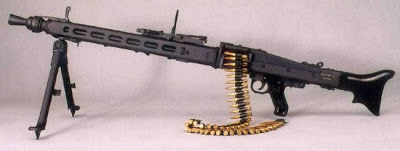MG 42 and MG 3 machine gun (Germany)

MG3 machine gun in "light machine gun" role, as made under license in Pakistan. MG3 machine gun in "mdeium machine gun" role, as made in Iran. Germansoldier aiming the MG3, fitted with EOTech holosight red-dot optics anda 50-round plastic belt container (which appears to be empty). MG 42 machine gun in LMG role, right sideview with bipod folded and carrying sling attached. MG 42 machine gun in MMG role, on infantrytripod mount Lafette 42. MG 42 machine gun in LMG role, left sideview, with bipod extended. Barrel change for MG 42 - barrelis unlatched and its breech part is exposed for removal. MG-42, bolt assembly schematic. MG-42,bolt assembly, with locking rollers and extractor claw seen at theright and belt-feed operating stud at the left. MG 42 MG 3 Caliber 7,92x57 7,62x51 Weigth 11,6 kg (gun) + 20,5 kg ( Lafette 42 t...



